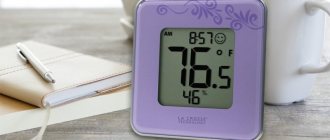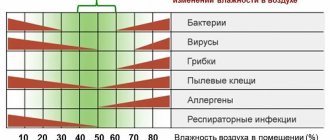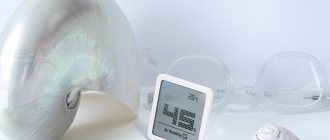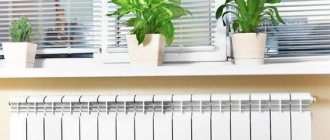How to check the air humidity in an apartment How to increase the air humidity in an apartment - Evaporation after a bath or shower - Drying things in the room - Do-it-yourself humidifier - Boiling kettle - "Musical" method - House plants - Ventilation and wet cleaning
How to reduce air humidity in an apartment (5 ways)
With the onset of the heating season, the air in the apartment becomes much drier, and therefore more dangerous. It negatively affects the skin and mucous membranes. It is because of this that in winter many people develop diseases such as sinusitis and sinusitis.
You can avoid the terrible effects of dehydrated air by increasing the humidity in the room. In this article we will tell you how to use a chilled glass of champagne to understand that the air at home is too dry or too humid (this is also bad).
We will also list several ways to independently increase or decrease the level of humidity in the room.
What should be the humidity in the apartment?
Normal indoor air humidity for humans is on average 45%. Naturally, this indicator cannot be constantly at the same level and there are deviations that will not cause negative consequences. The level of humidity in the house varies for rooms depending on their purpose:
- In the hallway, living room, bathroom, kitchen or dining room, humidity should be between 45-60%;
- In bedrooms for adult family members - 40-50%;
- In children's rooms, humidity should be maintained in the range of 45-60%;
- In the office and library, the lowest level is required - 30-40%. Printed paper and dampness can cause substances harmful to human health to appear in the air, not to mention the negative effect of damp air on books and documents.
Constantly maintaining a fixed level of humidity at home is quite difficult, because it is extremely sensitive to many factors, the most common of which are:
- Seasonal climate change;
- Changes in weather conditions;
- Working in a room with heating or air conditioning systems;
- Materials used for the construction of walls, their external and internal decoration.
In addition, the number and size of windows in the room, the presence of indoor plants and the way the household is run affect the moisture level.
Operating principle of the psychometer
Another device for measuring indoor air humidity is a psychometer . The mechanism of operation of psychrometric devices is based on the use of physicochemical properties of liquids.
For measurement, two degree tubes with liquid are installed on the device, one of which is wrapped in a wet cloth. When moisture evaporates, the temperature on the wrapped tube is lower than on the dry one.
Mercury and toluene are used as liquid materials for filling psychrometer thermometers. A device with toluene is less dangerous for household use
To obtain the result, you need to look at the air temperature on a thermometer that is not wrapped in fabric, and calculate the difference in liquid readings between both tubes.
Next, in the first column of the table of values, find the air temperature according to the thermometer. Find the difference in values in the top line. The number at the intersection of the column and row is an indicator of humidity.
There are three types of psychrometers:
- Stationary . A simple device consisting of two thermometers enclosed in a meteorological flask. One of the thermometers interacts with a damp cloth, due to which the liquid changes its physical and chemical properties and a difference in degrees appears. The results are calculated from the table.
- An aspiration psychrometer is similar to a stationary one, the difference is that an aspirator fan is installed in the protective housing to move compressed gas. A kind of vacuum creates conditions for obtaining the most accurate indicators.
- The remote device can be manometric or electrical. The design contains pressure gauge thermometers or thermistors, which change resistance depending on the state of the external environment. The finished results are displayed on the digital display of the device.
Consequences of deviations from the norm
The main signs of a high concentration of moisture in the room are the formation of condensation on window glass, a tactile sensation of dampness on the upholstery of furniture and things, darkening and accumulations bloomed in the corners of the rooms. After some short time, a musty smell characteristic of mold formations appears, which permeates all things and is subsequently quite difficult to remove.
But the smell of dampness is far from the most serious problem. Being in a room with mold on the walls is dangerous to your health. This can cause a number of diseases:
- Fungal formations irritate the human respiratory tract, and a significant concentration of them over time provokes the occurrence of allergies. Together, these two factors lead to the appearance of a pathology such as asthma, complicated by allergic reactions.
- High relative humidity promotes more intensive growth of cancer cells in cancer patients, which makes treatment difficult even in the early stages.
- Exacerbation of cardiovascular diseases. It is especially difficult for hypertensive patients, who are already severely affected by climate change.
Dry microclimates are less dangerous, but can also cause a number of negative health effects. What is harmful is not that the body does not receive enough moisture from the inhaled air. Dry dust particles, which do not settle on the surface of objects, are more harmful, but are located around and easily enter the human body through the respiratory system. The situation is further aggravated by the fact that the mucous membranes also dry out and do a poor job of catching dust, which has become even more abundant. In addition, immunity decreases, kidney dysfunction may occur, and dysbacteriosis develops.
Methods for measuring indoor humidity
There are a number of ways to find out the moisture level in a room. Some of them involve the use of special devices, others allow this to be done using items that are found in almost every home.
Several ways to measure air humidity - video:
Hygrometer
This device is specially designed to determine air humidity. With its help, you can accurately measure this climatic parameter with an accuracy of up to 1%. Modern models are multifunctional and, in addition to humidity, they will also determine atmospheric pressure, air temperature, exact zone time and some other parameters.
But what to do if you don’t have a hygrometer at hand, and you need to find out the humidity immediately. There are ways to do this using more common devices and tools.
Thermometer
Any attempts to determine the humidity level without a device will have a significantly greater error than the 1% for a quality hygrometer. Nevertheless, they will allow you to get at least an approximate idea of the level of humidity in the room.
To take measurements, you will need a regular mercury or alcohol thermometer to measure the temperature in the premises. With its help you need to do the following:
- Measure the temperature in each room (in order not to confuse the data obtained, it is better to write them down);
- Wet a piece of cloth or cotton wool in water at room temperature and wrap it around the part of the device that contains the bulk of the working fluid.
- Re-take measurements in the rooms and record the measurement results.
Next you need to calculate approximate values. To do this, the second readings are subtracted from the first, and the resulting result is converted into a humidity level using the Assmann psychometric table.
Glass of water
The most affordable and easiest way to find out humidity without a hygrometer. It does not require any calculations, lengthy measurements with recordings, or special equipment. Unfortunately, the accuracy of the readings obtained using a glass may differ significantly from the actual level of measured data. But if you follow the instructions exactly, critical deviations from the norm will be recorded.
- We fill a large glass glass (or any other glass vessel) with water. For greater clarity, it is better to fill the container completely, but so as not to splash the water during further movements.
- Cool the measuring instrument to a temperature of approximately 5˚ (for example, in the main chamber of a refrigerator for half an hour).
- To measure humidity, take out a container and place it in any place in the room that is not exposed to heating devices or air conditioners.
Condensation immediately forms on the walls of the vessel. Subsequent analysis of the result comes down to studying what happens to it.
- If the condensation dries out after 10–15 minutes, this indicates that the air in the room is dry and needs to be humidified.
- If there is an excessive concentration of water in the air of the apartment, the condensation on the walls of the glass will not dry in 10–15 minutes, it will collect in drops and flow down.
- At normal humidity, condensation will not form droplets and will not evaporate quickly.
What to look for when buying?
Indoor models of devices for measuring the amount of moisture in the air include mechanical and electronic hygrometers. They have a compact design, are safe for others and produce minimal errors in calculations. To support the design idea, modern devices have a laconic design.
Criterion #1 - operating principle
Mechanical and digital hygrometers have a number of advantages that can influence the choice of device.
The advantages of mechanical models of moisture meters include the following:
- the operation of the device does not depend on external power sources;
- they are easy to use since minimal additional adjustment of the necessary operating parameters is required;
- the cost of a mechanical hygrometer is slightly lower than an electronic one.
Digital models are made in the form of folding, portable gadgets.
In addition, the advantages of electronic models include:
- high speed of results;
- smaller reading error compared to a mechanical device;
- The output data is subject to further processing due to the presence of built-in internal memory.
Some electronic moisture meters combine several devices at once: hygrometer, clock, calendar, thermometer, barometer, dew point meter. Therefore, if a device performs several climatic functions, it is a stationary weather station .
Some moisture meters have a built-in alarm system that triggers when the steam level drops or rises between 30 and 60%. Such a device should be in homes where the climatic conditions of the region suggest high humidity or dry air
For the comfort of the child and parents, a hygrometer can be built into the baby monitor. This device has great functionality and an alert system.
The latest models are equipped with a Wi-Fi module to display information about the weather in the region by receiving data via the Internet.
Modern models of hygrometers are designed for specific specifics of work, so in order to accurately measure the air humidity in a room, apartment or other premises, you need to understand how the device will be used. Then the purchased moisture meter will fully meet the necessary requirements.
Criterion #2 - Humidity Range
Optimal air humidity is determined by the purpose of the premises. In bedrooms and living rooms, normal moisture meter values range from 20 to 80%. Near the balcony, in the hall, attic and in the kitchen from 10 to 90%. We recommend reading more about air humidity standards in an apartment in this material.
In moisture-filled rooms, the range of operating values can reach 100%. The wider the range of values captured by the device, the higher its price. Therefore, when choosing a gadget for bedrooms, halls and attic space, you can opt for devices with a small range of values.
When purchasing a hygrometer, study the performance characteristics specified in the product data sheet. It is important that the device parameters include the upper values of the range of expected operating temperatures
For some moisture meters, the maximum heating threshold is important. Thus, a device for a bath or sauna should include in its operating temperature range values up to 120 °C. Therefore, in rooms where temperature and humidity can reach quite high values, you should purchase special instruments for measuring vapors in the air.
Criterion #3 - measurement accuracy
For the equipment of special storage facilities, instruments with the smallest reading error are required.
So, in a home wine library, the humidity of the circulated air should be kept at 65-75%, and the content of water vapor in the library should not be lower than 50 and higher than 60%.
Therefore, to measure the moisture in the air in such rooms, you should use a psychrometer or a high-precision electronic hygrometer, which measures the amount of water vapor by changing the electrical conductivity of the air.
The error of a psychrometer ranges from 1 to 5%, the error of a digital device is from 5 to 10%. Therefore, they can be used in rooms where air humidity must adhere to precisely specified values.
If the humidity level does not meet the standards, but you will need a device to increase it - a humidifier.
Humidify the air in the room
There are ready-made solutions - so-called humidifiers. If you do not want to purchase such a device, you can use improvised means. In winter, you can place a container of water or a damp towel on the radiator in a dry room. Deciduous indoor plants, in addition to oxygen, produce a considerable amount of moisture, which will also help in eliminating an overly dry climate. Well, as a last resort, you can periodically turn on the electric kettle in a humidified room (many factory humidifiers work on the same principle).
Criterias of choice
In order to choose a quality device, study the following parameters:
- Hygrometer designs: psychrometric type, mechanical devices and electronic devices.
- Measuring range. Since humidity levels in residential premises decrease significantly during the winter season, you need a device capable of measuring in the range of 20.0-70.0%; in wet rooms - bathhouses, basements, you will need a device with a scale of up to 100.0%.
- Accuracy. For household measurements, a device with a division of up to 2-3% is sufficient, for more accurate ones up to 1%. This level can only be provided by an electronic device or psychrometer.
- Design. For many buyers it has special significance; for a bathhouse it is usually a model with a wood or stone finish, in the living room plastic products are harmonious, and for children's rooms an ideal option is made in the form of a toy.
Thus, we can summarize that a hygrometer is a very important and inexpensive device for household use, which helps to timely establish the actual humidity, both indoors and outdoors, so that the user can promptly protect himself and his loved ones from the harmful effects of excessively humid, and dry air.
Making a drier microclimate in the apartment
If the test shows high humidity, everything is a little more complicated. It is not always possible to correct the situation with improvised means and affordable household appliances.
The easiest, but unfortunately not the cheapest and most accessible way is to purchase a special dehumidifier. These devices do not heat or burn the air, and some are able to maintain humidity according to specified parameters. If there is no device, it is recommended to ventilate the room more often. This must be done regardless of the weather outside and the time of year. For rooms where natural ventilation is difficult, hoods should be used.
Determining the level of air humidity in the apartment is half the battle. It is necessary to constantly monitor it, and if non-compliances with standards are detected, immediate measures must be taken to eliminate these non-compliances.
How to maintain optimal moisture levels?
The smartest way to maintain optimal humidity levels is to use a humidifier with a hygrometer. Thus, you can control and adjust the indicator to the desired value. In addition to humidifiers, the following measures will help increase humidity:
- Get an aquarium;
- Place more flowerpots;
- Carry out wet cleaning regularly;
- Hang wet towels on radiators in winter;
- Place vessels with water on the radiator, or place them around the room;
- Leave the bathroom door open after using hot water.
To get rid of excess moisture, you can use special devices such as a dehumidifier or moisture absorber. The exhaust system helps remove warm, water-saturated air. A fan is used for greater efficiency. On a sunny day, you need to open the curtains so that the rays dry the air in the room.
Ventilation is a must to maintain optimal performance. Regardless of the weather, it is necessary to regularly ventilate the apartment.










